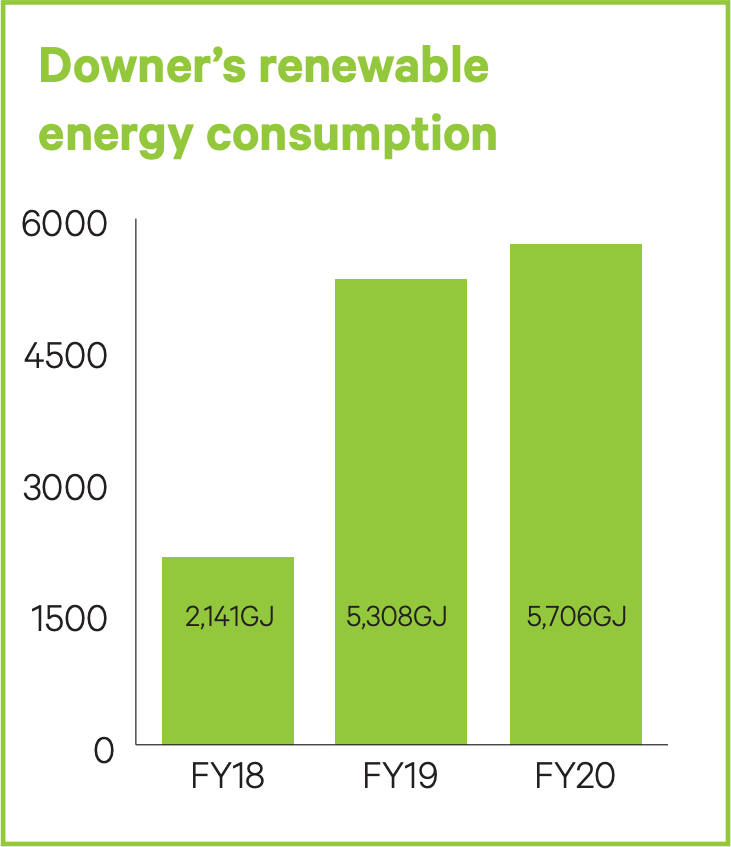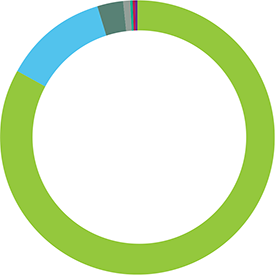Emerging issues and market trends
The circular economy – low carbon materials and products
Downer is committed to reducing the environmental footprint of the products we provide to our customers. Emissions is one component of this. Natural resource usage is another and Downer is committed to the principles of the circular economy, including understanding products’ lifecycles, to ensure that their burden on the natural environment is kept to as low a level as possible.
The demand from our customers, communities, industry and government for circular economy thinking to reduce waste continues to be an important issue.
Downer demonstrates our commitment to the circular economy in the following ways:
- Investment in our Reconomy business
- The purchase of a 50 per cent stake in Repurpose It, a waste resource company in Victoria that is a thought leader in the innovative diversion of landfill with a focus on finding sensible reuse for the materials that result from some of our processes
- Downer’s use of waste materials in Australia and New Zealand such as hard and soft plastics, glass and printer cartridge toner within our road asphalt products, diverting these products from landfill
- Development and marketing of Reconophalt™, a Downer product which incorporates recycled soft plastics and glass into asphalt road construction.
In FY20, 14 per cent of total asphalt production in Downer was made up of recycled materials. This decreased from 14.25 per cent in FY19. The consequent GHG emissions reductions are outlined in the chart on the below.
GHG emissions reductions
Please visit this page on your computer for access to trends data
Infrastructure rating tools
Customers are increasingly specifying ratings for their projects, which presents us with challenges and opportunities. The application of sustainability rating tools for nominated infrastructure projects allows us to address, mitigate and manage climate-related risks. Some of Downer’s successes in infrastructure sustainability include:
- Obtaining the first IS Operational rating in Tasmania for the Northwest Tasmanian Road Maintenance Contract
- Continuing on from last year’s ‘Excellent’ Design rating, the Newcastle Light Rail project achieved an ‘Excellent’ IS As Built rating for the successful delivery of the light rail infrastructure
Protection of the environment and biodiversity
Biodiversity is the variety and variability of living organisms on the planet. Earth’s ecosystems are driven by biodiversity, and any disruptions can have ripple effects that may be harmful to other life forms and the environment. Downer’s impact on biodiversity varies based on the location and size of a given site, and the type of work that is being carried out.
As a proactive measure, Downer responds to its potentially negative impacts on biodiversity with initiatives at select construction sites.
We also contribute positively to biodiversity through the services that we deliver, particularly our land management services. On a site-by-site basis, work is done to ensure appropriate protections are in place where these operations overlap with protected areas, or areas of high biodiversity value.
In FY21, Downer will look to aggregate and report all site operations that have a significant effect on biodiversity as well as mitigation and restoration measures undertaken.
Increasing use of technology
Automation and the increasing use of advanced technology in the workplace, industry and community is a fact of modern life.
Downer increased our use of smart solutions in FY20, including electric vehicles, automated vehicles and unmanned aerial vehicles.
In FY19, Keolis Downer joined Flinders University, the South Australian State Government and other industry partners in a five-year trial of autonomous vehicle technology in Adelaide. Keolis Downer also launched a new 12-month pilot program of driverless vehicles in Newcastle in July 2019. The trial was successful, and the driverless/autonomous vehicle is now in service and forms part of Newcastle’s integrated transport system including buses, ferries and light rail.
Downer continues to use unmanned aerial vehicles, commonly known as drones. We have pioneered the use of drones to improve safety, cost and efficiency at a number of sites. Drones are now commonly used across the business to carry out tasks including asset inspections and environmental monitoring inspections.
In addition, Downer has been using artificial intelligence (AI) and machine learning to perform processes and activities in a timely and accurate way, allowing our human capital to carry out more complex strategic tasks. Downer and Spotless have also been utilising AI and machine learning, combined with aerial imagery taken from drones, to identify and assist in the eradication and management of noxious weeds.
Through the Microsoft Azure platform, Downer has been able to present information and dashboards in new ways that have provided efficiencies and have also allowed us to digitalise our management systems, so that administration and work can occur in the field in real time.
Energy transition: Growth in renewable energy and electrical distribution
In FY20, renewable power generation in Australia continued to accelerate. According to the Clean Energy Regulator’s latest Quarterly Carbon Market Report (which, at the time of this report’s publication, was the March Quarter 2020 report), the Clean Energy Regulator expects approximately 3,400MW of large scale capacity will be accredited in 2020, taking the total to around 15,000MW generated since 2017.
Downer remains one of the most experienced providers of design, build and maintenance services to Australia’s renewable energy market. To date, Downer has delivered 17 wind farms and six solar farms, which generate 2,806MW of renewable energy. Wind and solar projects delivered by Downer are estimated to have produced enough electricity to power approximately 950,000 homes and avoided over 4,500 ktCO2-e in emissions9. In FY20, Downer completed the Murra Warra Wind Farm which has a generation capacity of 232MW, and the Limondale Solar Farm which has a capacity of 349MW. At the end of FY20, Downer had 315MW of solar and wind farms under construction.
In February 2020, Downer announced we would withdraw from the construction of large scale solar-to-grid projects, as there are too many inherent risks due to large power loss factors, grid stability problems, connection risks, and equipment performance issues.
Downer increased renewable energy consumption from 5,308GJ in FY19 to 5,706GJ in FY20 in its own operations, primarily from solar PV on rail maintenance, laundries and educational facilities.

- The disclosure of how many homes powered by solar and wind projects Downer has delivered has been calculated by dividing the total electricity generated for FY20 by the average household electricity use in Australia. Electricity generation figures have been obtained from AEMO’s ‘Actual Generation and Load’ reporting. Average household electricity consumption has been sourced from the Australian Energy Regulator’s Annual Report on Compliance and Performance of the Retail Energy Market 2017-18. Avoided emissions has been calculated using the total electricity generated figures sourced from AEMO for each generation asset, multiplied by emissions factor for the National Electricity Market (NEM), sourced from Table 6 of the National Greenhouse Account (NGA) Factors 2019.


